ISSN ONLINE(2319-8753)PRINT(2347-6710)
ISSN ONLINE(2319-8753)PRINT(2347-6710)
Prof.J.M. Raut 1 Dr. S.P.Bajad 2 Dr. S.R.Khadeshwar3
|
| Related article at Pubmed, Scholar Google |
Visit for more related articles at International Journal of Innovative Research in Science, Engineering and Technology
Construction projects like water reservoirs highways, railways, reclamation etc. requires earth material in very large quantity. Due to lots of power projects lots of ash is produced. This by-product is really a difficult and expensive. Also in urban areas, borrow earth is not easily available which has to be brought from a long distance. Most of the time, large areas are covered with highly plastic and expansive soil, which is not suitable for construction purpose. Extensive laboratory and field trials have been carried out by various researchers and have shown promising results for application of such expansive soil after stabilization with additives like cement, sand, silt, lime, fly ash, murrum, etc. As fly ash & murrum is freely available, for projects in the in nearby vicinity, it can be used for stabilization of expansive soils for various uses. The present paper describes a study carried out to check the improvements in the properties of expansive soil with fly ash, murrum in varying percentages. The laboratory tests have been carried out and results are reported in this paper
Keywords |
| Stabilisation, fly ash, murrum, laboratory tests . |
INTRODUCTION |
| The materials available for the construction of earthen embankments were fine sandy loam, gravel, clay and basaltic rock. The variable mixtures of the sandy loam and gravel could be successfully used for embankment construction, while the basaltic rock formed excellent material for slope protection. Gravel is suitable for the construction of an embankment. The weight and stability of gravel are both satisfactory, but gravel lacks the essential feature of water tightness as it often contains as much as from 35 to 40 percent of pore space. Murrum, on the other hand, while less porous than gravel, is much less stable and much more seriously affected by moisture as compared to gravel. Fly ash is quite impervious, but they lack in weight and stability and tend to swell and slump when saturated with water and to shrink and crack when dry. Consequently, fly ash alone is not suitable for the construction of an earth dam, excellently suited for an admixture with other materials. |
| The present investigation deals with the mechanical stabilization of clay with mixtures of murrum and fly ash Clays are quite impervious, but they lack in weight and stability and tend to swell and slump when saturated with water and to shrink and crack when dry (Sundar Kumar and Ratnakanth Babu, 2010). The Lateritic soil is popularly known as murrum. It is characterized by a deep weathered layer from which silica has been leached. There is no humus, but an accumulation of aluminium and iron oxides and hydroxides. The reddish colour of these soils is imparted by the iron compounds. Murrum are residual soils and are formed from weathering of basaltic rock at places, where monsoon is severe (Ketkar, 1970). They constitute mixture of weathered rock pieces in varying sizes, sand, silt and clays. They are good material for road construction. |
| The work presented in this paper consists results of index properties, compaction characteristics (optimum moisture content and maximum dry density) and shear strength parameters (cohesion and angle of shearing resistance) for the murrum blended with varying percentages of sand, clay, and combination of both sand and clay mixtures. |
II. LITERATURE REVIEW |
| Fly ash by itself has little cementations value but in the presence of moisture it reacts chemically and forms cementations compounds and attributes to the improvement of strength and compressibility characteristics of soils. It has a long history of use as an engineering material and has been successfully employed in geotechnical applications. |
| Erdal Cokca (2001): Effect of Flyash on expansive soil was studied by Erdal Cokca, Flyash consists of often hollow spheres of silicon, aluminium and iron oxides and unoxidized carbon. There are two major classes of flyash, class C and class F. The former is produced from burning anthracite or bituminous coal and the latter is produced from burning lignite and sub bituminous coal. Both the classes of fly ash are puzzolans, which are defined as siliceous and aluminous materials. Thus Fly ash can provide an array of divalent and trivalent cations (Ca2+,Al3+,Fe3+etc) under ionized conditions that can promote flocculation of dispersed clay particles. Thus expansive soils can be potentially stabilized effectively by cation exchange using flyash. He carried out investigations using Soma Flyash and Tuncbilek flyash and added it to expansive soil at 0-25%. Specimens with flyash were cured for 7days and 28 days after which they were subjected to Oedometer free swell tests. And his experimental findings confirmed that the plasticity index, activity and swelling potential of the samples decreased with increasing percent stabilizer and curing time and the optimum content of flyash in decreasing the swell potential was found to be 20%. The changes in the physical properties and swelling potential is a result of additional silt size particles to some extent and due to chemical reactions that cause immediate flocculation of clay particles and the time dependent puzzolanic and self hardening properties of flyash and he concluded that both high –calcium and low calcium class C fly ashes can be recommended as effective stabilizing agents for improvement for improvement of expansive soils. |
| Pandian et.al. (2002). Studied the effect of two types of fly ashes Raichur fly ash (Class F) and Neyveli fly ash (Class C) on the CBR characteristics of the black cotton soil. The fly ash content was increased from 0 to 100%. Generally the CBR/strength is contributed by its cohesion and friction. The CBR of BC soil, which consists of predominantly of finer particles, is contributed by cohesion. The CBR of fly ash, which consists predominantly of coarser particles, is contributed by its frictional component. |
| Phanikumar and Sharma (2004): A similar study was carried out by Phanikumar and Sharma and the effect of fly ash on engineering properties of expansive soil through an experimental programme. The effect on parameters like free swell index (FSI), swell potential, swelling pressure, plasticity, compaction, strength and hydraulic conductivity of expansive soil was studied. |
III. EXPERIMENTAL INVESTIGATIONS |
Index Properties |
| The murrum used in this study was collected from a quarry near Kalmeshwar, 32 km north to Nagpur district of Maharashtra. The fly ash used in the present work was collected from the Koradi power plant near Nagpur Maharashtra. The properties of murrum are presented in the table 1. The soil with maximum clay percentage used in this work was collected from nearby vicinity of Yeshwantrao college of Engineering, Wanadongri Nagpur. The properties of clay are presented in the table 2. |
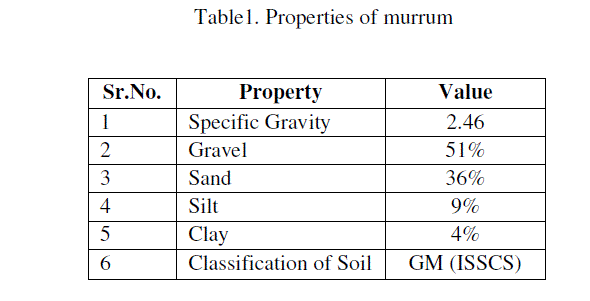 |
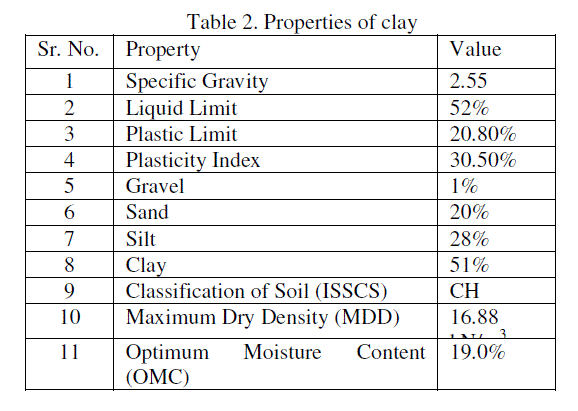 |
| The liquid limit and plastic limit values of clay-murrum mix increases with increase in percentage of murrum. The plasticity of the mixes is increased due to increased percentage of murrum imparts plasticity to the mix. The liquid limit and plastic limit values are decreases with increase in percentage of the clay mixed with combination of equal amounts of murrum and fly ash as additive. But the values are less compared to those of murrum-clay mixtures. This due to the plasticity of the mix is reduced due to addition of murrum along with fly ash to the mix. |
| In the present work, Clay was physically stabilized by adding 2.5%, 5%, 7.5% and 10% of murrum, similarly with fly ash and also with combination of equal amounts of murrum and fly ash, i.e., for 10% additive consists of 5% of murrum and 5% of fly ash. The mixing proportion is shown in the Table 3. After removing impurities like vegetation, stones etc. the soil was mixed with fly ash and murrum in varying proportion by volume. The Mixing was thoroughly carried out manually and the tests were conducted as per standard procedures. |
COMPACTION CHARACTERISTICS OF MURRUM MIXTURES CONCLUSION |
| After removing impurities like vegetation, stones etc. the soil was mixed with fly ash and murrum in varying proportion by volume. The Mixing was thoroughly carried out manually and the tests were conducted as per standard procedures. IS compaction tests were conducted on the murrum mixtures considered for this investigation to determine the maximum dry density (MDD) values and optimum moisture content (OMC) values and the results are shown in table 3. The variation of maximum dry densities and the optimum moisture contents for varying percentages of additives are shown in table 3 respectively. |
| The MDD values are increasing and OMC values are increasing with increasing percentages of murrum added to clay. This is due to sandy present in murrum particles fills the voids of the coarse grained particles of clay. The MDD values are decreasing and OMC values are increasing with increasing percentages of fly ash added to clay. This is due to increase in clayey content of fly ash causes in increase in finer content of soil in the murrum–clay mix. Further, the MDD values are increasing and OMC values are decreasing with increasing percentages of combination of murrum and fly ash, but the values are less compared to those of clay murrum mixtures. This is due to increase in fly ash along with murrum causes increase in finer content of the clay. |
UCS on Soil Mixtures with Fly Ash & Murrum |
| Unconfined compressive test on all the samples of soil mixtures with fly ash and murrum. It is observed from the table 4, as the percentage of Murrum additive increases the cohesion values of the clay mixture decreases and angle of shearing resistance values increases. Also unconfined compressive strength increases. With increasing percentage of fly ash additive, the cohesion values of the mix increases and angle of shearing resistance values decreases. As the percentage of murrum and fly ash combination increases the cohesion values of the mix increases and angle of shearing resistance values decreases up to 12.50% of murrum and fly ash combination and afterwards cohesion values are decreases and angle of shearing resistance values increases. |
IV. CONCLUSIONS |
| Based on laboratory test results, the following conclusions are drawn |
| 1. As the percentage of murrum and fly ash increases the MDD and unconfined compressive strength increases up to a certain proportion and afterwards value decreases. Maximum MDD and Unconfined compressive strength found for proportion of 7.5 % murrum and 5% fly ash. |
| 2. As the percentage of Murrum additive increases the plasticity of the clay murrum mixture decreases, the MDD values increases and the corresponding OMC values decreases. |
| 2. As the percentage of fly ash additive increases the plasticity of the clay fly ash mixture increases, the MDD values decreases and the corresponding OMC values increases. |
| 3. As the percentages of murrum and fly ash combination as additive increases the plasticity of the clay murrum fly ash mixture decreases and MDD values increases, the corresponding OMC values decreases. But values are small as compared to clay- murrum mix case. |
| 4. It is observed that the strength of the Clay mixed with 7.5 % of murrum and 5 % fly ash combination as optimum combination to improve its properties. |
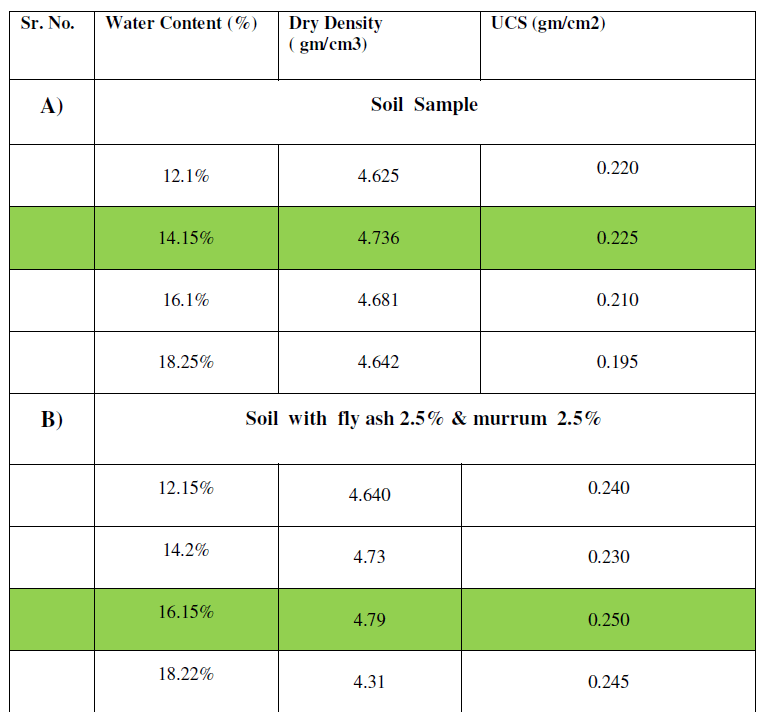 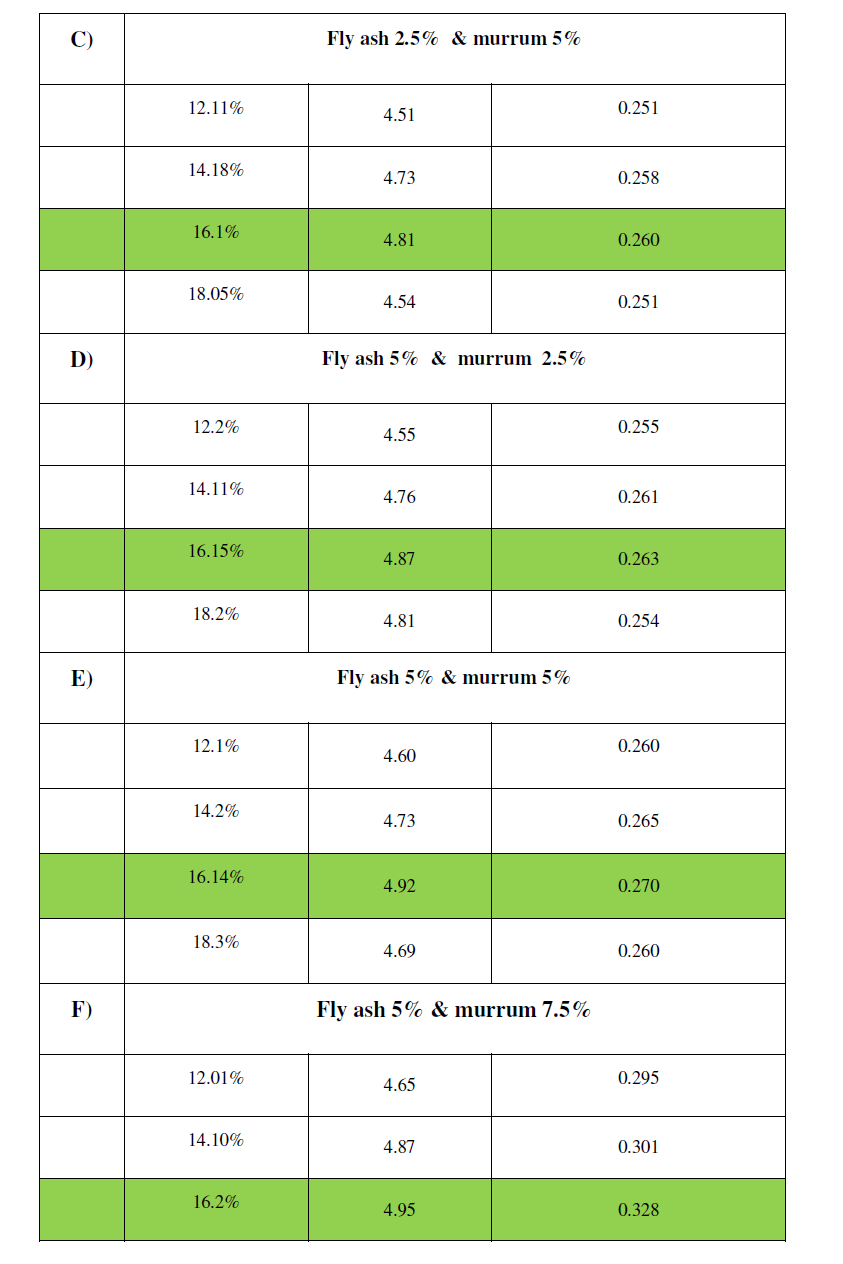 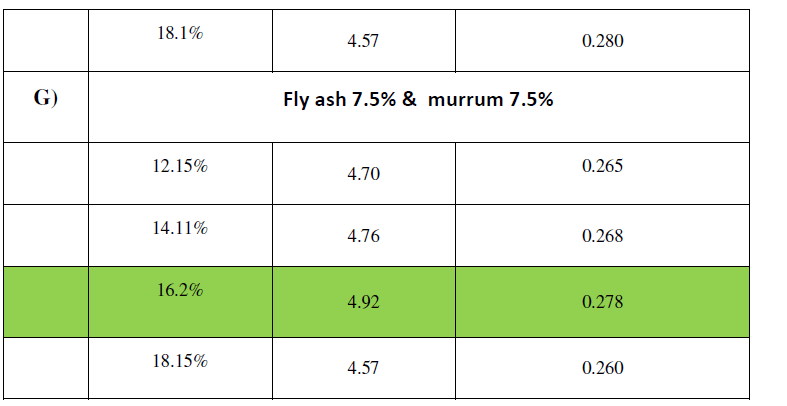 |
References |
|